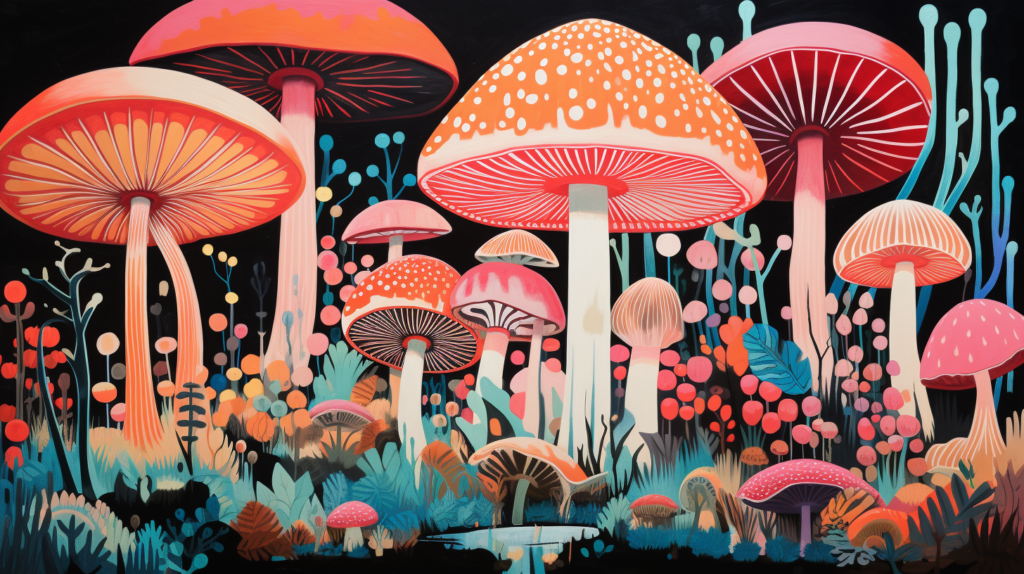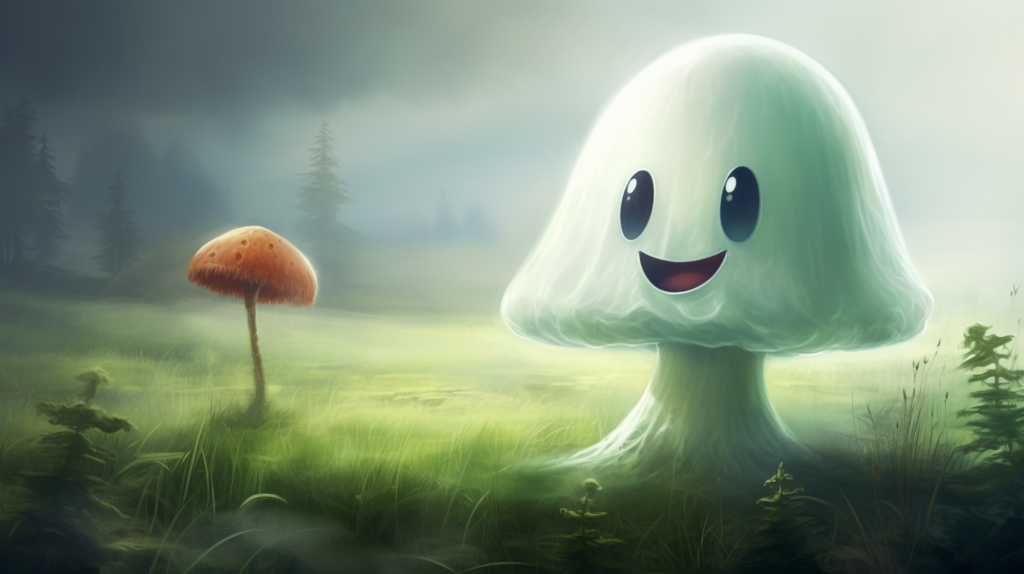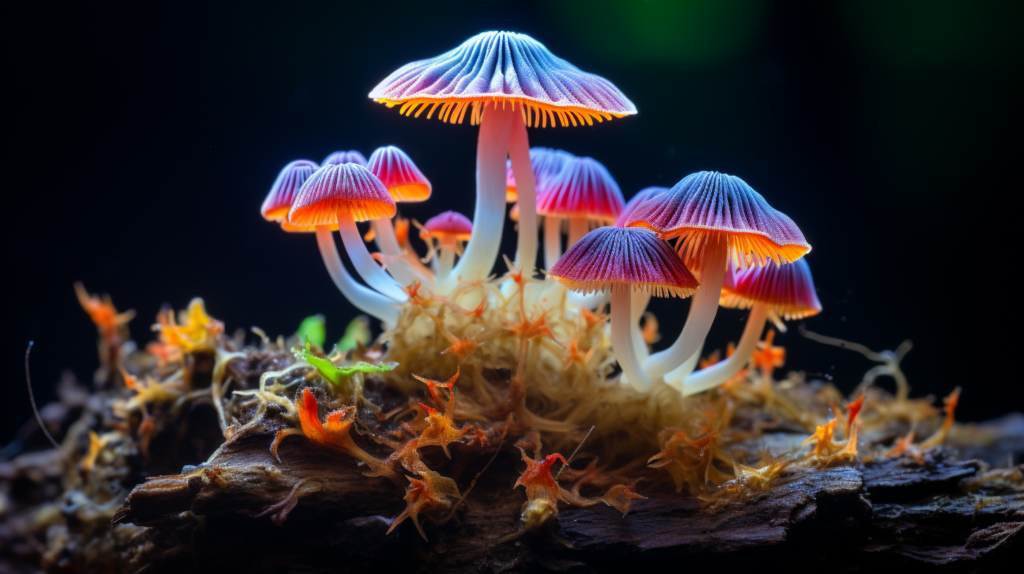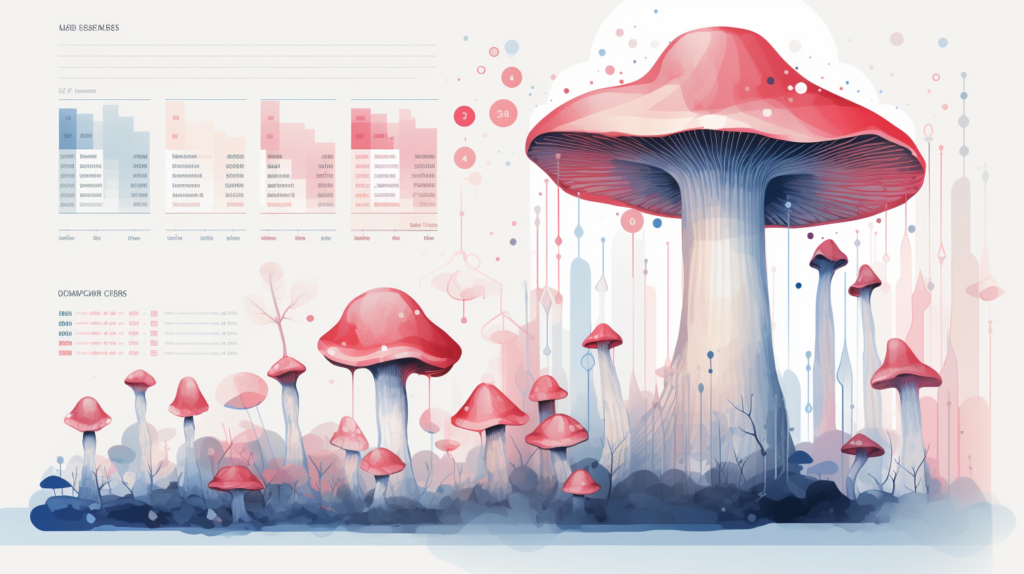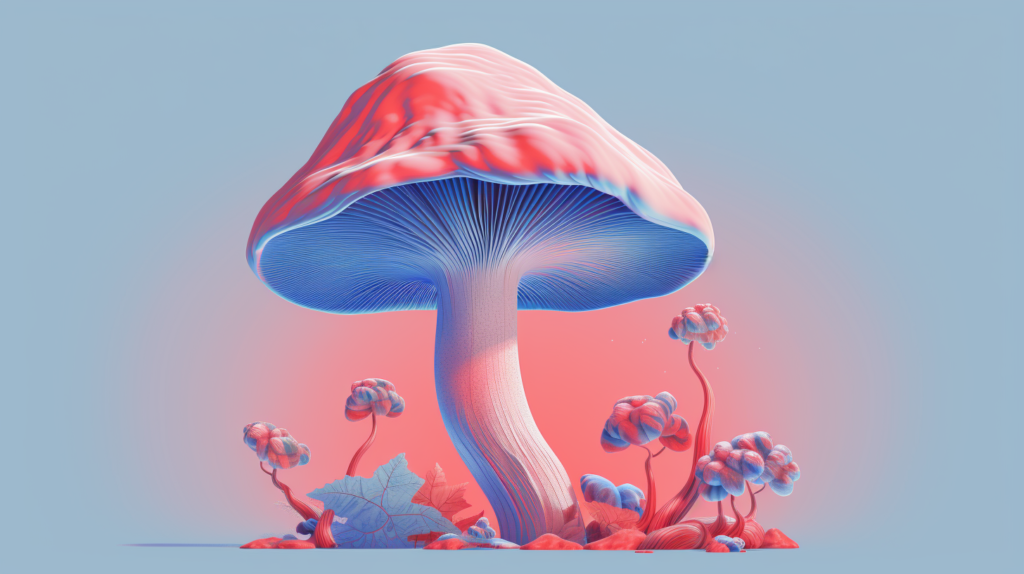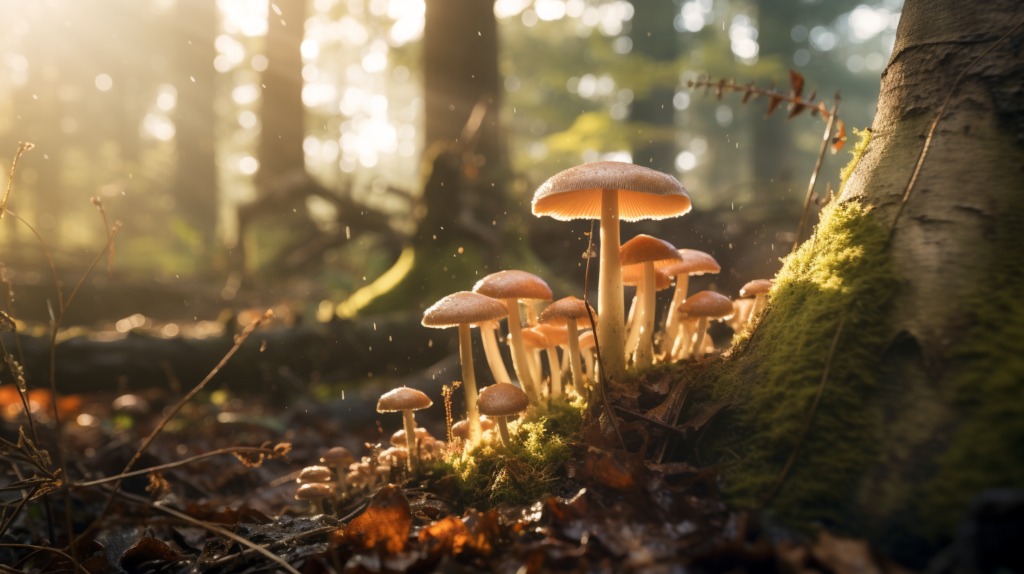0:00:05.3 April Pride: Hey, I’m April Pride, your host on The High Guide Podcast. This is the show for women who have an open and curious mind, and this is a show all about women changing their lives thanks to altered states of consciousness. Did you miss me last week? [chuckle] I was in Denver at MAPS PS23, or the MAPS Conference, Psychedelic Science 2023. On this episode, I’m sharing my notes as a media pass holder, and I’ve asked a couple of my favorite women to share their thoughts on the conference as well. Lots of cocktail party fodder for you to take in and share, including the three themes I heard repeated by speakers throughout the day and attendees over drinks after long days. [chuckle] I’ve included these as today’s trip tips, so stay tuned through to the end to hear more, including a shroom strain review of Enigma. Let’s get into the scientific future of tripping.
0:01:00.4 AP: Now for the word of the week, MAPS. MAPS stands for Multidisciplinary Association for Psychedelic Studies. It’s a nonprofit research and educational organization that focuses on studying the therapeutic potential of psychedelic substances and advocating for the responsible and legal use. Founded in 1986 by Rick Doblin, MAPS is dedicated to developing medical, legal, and cultural context for the safe and beneficial use of psychedelics. The primary mission of MAPS is to conduct rigorous scientific research into the therapeutic applications of psychedelics, including substances such as MDMA, psilocybin, LSD, and others. MAPS sponsors and supports clinical trials and studies that investigate the safety and efficacy of these substances in treating various mental health conditions, such as post-traumatic stress disorder, depression, anxiety, and addiction.
0:01:52.2 AP: MAPS also plays a crucial role in advocating for policy reform and educating the public about the potential benefits of psychedelic-assisted therapy. The organization engages in public outreach, provides educational resources, and collaborates with policymakers, researchers, and healthcare professionals to promote evidence-based approaches to psychedelic research and therapy. In addition to its research and advocacy efforts, MAPS is committed to training therapists and clinicians in the responsible use of psychedelics in therapeutic settings. The organization offers training programs and workshops that provide healthcare professionals with the necessary knowledge and skills to work with these substances safely and effectively.
0:02:29.7 AP: Okay, so the MAPS conference. Here’s some history with numbers that I think will intrigue you. So they’ve had four conferences, the first being in 2010 in Oakland, and it hosted 900 people. Three years later, 2013, there were 1,800 people that attended the second conference. The conference held just before this last one last week was in 2017, also in Oakland, and there were 3,000 people there. Last week in Denver, there were 12,000 people. So that’s a fourfold increase since the last conference. And we’ve all seen the headlines. We know that there’s research that’s being done in psychedelics for medical purposes and the pandemic, right? It just took this topic and exploded it. So there were a lot of people there, and there were so many researchers to listen to that are doing fascinating work all around the globe, particularly in South America, a lot of Brazilian researchers that, working with, Ayahuasca.
0:03:25.7 AP: I guess one of the things that’s the most fascinating to me about the conference is that [chuckle] there is not a clear legal path to operate a business with the future unclear, and certainly limited in the current moment, a lot of people want to know, I don’t know, how they can be a part of this, not just professionally, but how it could potentially play a role in their own transformation personally. So let’s go through my notes from the three days. Day one of the conference coincided with the first day of summer, the solstice. And at 10 o’clock in the morning, the first lecture I attended was The State of the Stone, Updates from Underground Psychedelics. This was hosted by Earth and Fire Erowid. Erowid, spelled E-R-O-W-I-D, and you’ll be able to find this in the show notes, is a passionate community seeking to redefine society’s understanding of mind-altering substances. Okay, the Erowid website is super analog. [chuckle] It was developed in the ’90s, and for those of you who are surfing the web at that point, but do not let its rudimentary look and feel dissuade you from getting really lost in this rabbit hole.
0:04:35.9 AP: This website, the Erowid website, is a comprehensive online resource dedicated to providing accurate and unbiased information about psychoactive substances, including drugs, plants, and chemicals. It serves as a vast repository of knowledge, documenting the experiences, effects, risks, and benefits associated with a wide range of mind-altering substances. One of the unique features of Erowid is its intense collection of trip reports contributed by users. Yes, this is the reason to go to the website, because people talk about the exact drug they were taking, their dose, the experience they had, I mean, I’m trying to remember, I think there are 48,000 of them. These firsthand accounts provide invaluable insights into the subjective experiences of individuals who have experimented with various substances. Trip reports often include detailed descriptions of dosage, effects, set and setting, and personal reflections offering a nuanced understanding of the psychedelic experience. Erowid places a strong emphasis on harm reduction and responsible drug use.
0:05:31.1 AP: Okay, so at the conference, Earth and Fire talked about over-pathologizing of individuals’ neurocognitive state in order to be able to use psychedelics for medical purposes, which I absolutely appreciate. They talked about 2C-B. So 2, the number 2, the letter C, capital C, hyphen, letter B, capital B, 2C-B is a novel compound that came out of Shulgin’s lab. And Shulgin is Alexander Shulgin, Erowid, Earth and Fire Erowid worked with him and in fact have all of his files as a chemist and his wife Anne’s files as a therapist that they are currently digitizing a quarter million of them. And so 2C-B came out of Alexander Shulgin’s lab, this novel compound, he’s responsible for I think hundreds. 2C-B was first synthesized in the lab of the great Alexander Shulgin in 1974. 2C-B has been described to me and I’ve consumed it. It’ll make you feel empathetic as if you’ve taken MDMA and it’s energizing and visual hallucinations similar to LSD. Yeah, I guess both of those things were true. I don’t know. I don’t know if it worked for me.
[laughter]
0:07:00.1 AP: Actually. 2C-B is what’s known as a novel compound. A novel compound. In the case of psychedelics, they’re trying to find a new way to get high, and a way to outrun the law, right? Because if it’s a compound that hasn’t been scheduled then it’s not illegal. And novel compounds were definitely a theme at the conference. So back to 2C-B. Well, On the street [chuckle] there’s something called tucibi, T-U-C-I-B-I, which comes out of Central and South America particularly Columbia. It’s also being called pink cocaine and sometimes purple cocaine on the streets. But it’s not cocaine at all. It’s a mixture of ketamine, caffeine and MDMA. Just know that if someone offers you pink cocaine, it is not cocaine, [chuckle] it is caffeine with Molly and Cat. So immediately following Erowid where Mohawk Green and Mitchell Gomez of Dance Safe and they presented Setting in Medicine Dance Safe is a nonprofit harm reduction organization dedicated to promoting health and safety within the nightlife and electronic music communities.
0:08:08.4 AP: Founded in 1998, year I graduated university, Dance Safe aims to empower individuals to make informed decisions about the recreational drug use and to reduce the potential risk associated with substance use in these environments. The primary focus of Dance Safe is providing harm reduction services and education at music festivals, clubs and events. The overwhelming message that I got from Dance Safe is that people are dying from prohibition. People die from prohibition and isolation due to the shame regarding their choice of drugs. And in particular I’m talking about opiates. He mentioned that there are promoters who are anti harm reduction and he said, “don’t go to those shows, vote with your feet”. A harm reduction is a term that should be replaced with benefit maximization. The argument was made and they also argued against decriminalization legalization because we need a regulated drug supply. The other thing that was emphasized is to make drug decisions before you take the drug.
0:09:09.4 AP: Don’t do your research after you’ve consumed, know what you’re taking well before you ingest. I thought that that was funny but you know what? It’s important to mention. This is another thing that was presented about novel drugs they’re more dangerous because they’re new and fewer people have been guinea pigs to… This to me was a big thing at the conference, oh I heard they’re bringing this new drug and I guess at a conference of people who’ve probably tried a lot, perhaps it all, finding a new way to get high or a new type of high, yeah that would be novel. Just know just be careful. Right? Just sort of like the 2C-B becoming tucibi, there’s a lot of research so don’t get high and then do your research. The other thing that was emphasized is that most deaths are black stimulant users.
0:10:00.4 AP: The mic drop moment for this lecture was when Mitchell Gomez said, “You don’t have a better drug supply than Prince”.
[music]
0:10:08.4 AP: Next up was a press conference with the Alexander Shulgin Research Institute. Speaking of, they announced the identification of two lead compounds currently undergoing late stage preclinical testing. The first is ASR 2001. This is non-psychoactive. It’s being hyped as a substitute potentially for Adderall or Ritalin to produce a focus state but without the dopamine push. The indication is that the outcome you’ll achieve what people are trying to achieve with microdosing but it’s better for daily use. And the second is ASR 3001 a short acting psychedelic, which produces a short acting psychedelic experience with an onset of eight to 10 minutes. Duration is an acute two hours, it creates an internal state like other psychedelics which is great for therapy but it’s not such an immersive process.
0:10:55.8 AP: Both compounds are three to five years away to market. On the main stage at 12 o’clock was Dr. Andrew Huberman of the Huberman Lab. I didn’t really have a lot of notes for this. I just took a picture and sent it to my kids because they like his podcast. He talked about his own MDMA experiences. He is most interested in the neuroplasticity that is alivened by psychedelics. Following Dr. Andrew Huberman, Julie Holland. Dr. Julie Holland interviewed Melissa Etheridge. You’ve heard Dr. Julie Holland on a previous episode of this podcast. Dr. Holland wrote Good Chemistry. She and Melissa discussed the melissaetheridgefoundation.org which I’ll include in the show notes and her soon to be released book, Talking to Angels, about the loss of her son to fentanyl overdose. And she talked about his surprising road to addiction through speed skating and a broken ankle that led to his fatal dependency on opiate prescription drugs.
0:11:47.9 AP: Rick Doblin, the founder of MAPS, held a press conference at 1:30. MAPS is only giving access… There are two things that I found interesting at this press conference. One MAPS is only giving access to therapists that themselves have had psychedelic experiences. The other thing that he mentioned and citing Dr. Carl Hart, the more dangerous the drug the more it should be legal. I heard this from multiple people over the course of the conference. If you don’t know who Dr. Carl Hart is, he wrote Drug Use For Grownups. The grownup for this conference was Amanda Feilding the queen of a psychedelic renaissance.
[music]
0:12:24.7 AP: She drilled a hole in her head. You should look that up. I’m just saying that’s commitment. Getting to your right high. Her fascination is with glucose. And the research that she’s funding and participating in all over the world is the effect of glucose on a psycho-actively charged brain. The afternoon of day one I spent time listening to researchers from Brazil on Ayahuasca. Something that jumped out at me, humans see things when they’re under the influence of psychedelics and humans need to see things to believe them. So we’ve talked about ketamine on this show and the fact that ketamine is used for acute suicidal ideation and will completely reverse those suicidal thoughts within an hour of treatment. Right? So The greatest effect of ketamine is within that first 24 hour period. The greatest effect of Ayahuasca is after 7 days. So your integration after Ayahuasca is long. I was super wiped after day one. [chuckle]
[music]
0:13:29.2 AP: I watched Roland Griffiths kick off day two in a keynote speech that I watched from the press room on a television. His speech was on spirituality, mindfulness, and mortality. Roland Griffiths is a prominent figure in the field of psychedelic research and consciousness studies. He is a professor of psychiatry and behavioral studies at Johns Hopkins School of Medicine in Baltimore. Bal’imore, for those of you who are from the Mid-Atlantic. [chuckle] Roland Griffiths is well known for his groundbreaking research on the therapeutic use of psychedelics, particularly psilocybin, the psychoactive compound found in magic mushrooms. And the research uncovered the critical inclusion of the mystical-type experience while in an altered state as a predictor, enduring well-being and spiritual discovery, meaning if you have a mystical-like experience while under the influence of psychedelics, you are more likely to be forever impacted by that experience.
0:14:23.9 AP: On that day, I also interviewed four people for the podcast, and I’ll share more of those interviews in a later episode. That evening, went and saw The Flaming Lips. They played the album Yoshimi Battles the Pink Robots from start to finish, and I probably listened to the first five or six songs before I went home. Day three, I watched the expo floor, and I met with Natasha Lannerd, who you’ll recognize as our High Guide integration facilitator from season three of this podcast. I asked her to share a voice memo with her thoughts on the conference, and here’s what Natasha had to say.
[music]
0:15:00.3 Natasha: Hi there. Excited to give my two cents on the conference. Hopefully, I can provide some insight and [chuckle] or some points of interest. Let’s see. Where to begin? I think one of the largest takeaways on the conference, looking back on it, really is a reflection of almost the social science that went into all of this. I had my first therapeutic psychedelic experience almost 20 years ago. And after that experience, I knew very clearly that this had the potential of really changing people’s lives. And at that moment, 20 years ago, I’m like, “One day, this is gonna be a thing.” And to be in Denver, in my hometown, at a conference that ended up being the largest conference in Denver history, with nearly 12,000 people in attendance, it was the acknowledgement that this is not a fad. This is not a trend. This is a movement of other people that have either experienced firsthand the benefit of psychedelics or see the benefit of how it could impact someone that they love.
0:16:17.5 Natasha: And at the end of the day, one of the things about this movement that I think is powering it and giving it credibility and removing the barriers of politics and religion and all of that is that every single person in the world knows someone that suffers, and everybody wants peace for that person in their life if it’s them, if it’s someone that they love. And in order to get people that peace, people are willing to take matters into their own hands and to try things that maybe are considered more experimental. So just seeing the sheer volume of people come here, make the trip, showing up every day to the conference to connect and to really kinda come out and share themselves and contribute to this, I think that, that was probably one of the biggest things.
0:17:13.5 Natasha: What was also interesting for me, and I appreciated MAPS’ approach in this, is how they gave audience to people that have been practicing this work underground for years. I was very fortunate to see my teacher who I studied with for many years give a talk, and seeing her on the stage was a moment for me of like, “Wow, this changed quickly.” I would say, as far as anything that really stood with me, it really just… Honestly, I learned a lot. I saw literally every person I’ve ever met in the psychedelics community, which is saying a lot. But really for me, the largest takeaway was the deep impact of seeing that, again, this is not a trend; this is a movement. And looking forward to the next time this conference happens, I just can’t imagine the magnitude and the size. And having worked in the cannabis industry for almost nine years and seeing the work that we’ve done here, and then just seeing psychedelics come in. I mean, cannabis laid the groundwork for this, but psychedelics are coming in. And psychedelics are happening so quickly. It’s an interesting thing to see.
0:18:32.5 Natasha: The last thing I’ll say, which is more or less my personal musings that I have had for quite some time, is that I find myself contemplating, quite deeply, the interesting universal timing and parallels of the psychedelics movement and the AI movement. And they’re coming out at the same time. And the parallels between these two technologies in that they are both incredibly powerful tools that have the potential to change a paradigm, and really what it comes down to is the intentionality of the use of both of these technologies is what dictates their benefit to the individual or society. And I spent a lot of time at the conference, before the conference, and frankly now observing the time frame of this and contemplating, just the interesting [chuckle] reality that we’re living with right now is that we have a tool that, obviously, is like an expressway for our minds, and then we have a tool that is an expressway for damn near anything we could do as a human. And psychedelics really unlock and remind us who we are as human beings. And so I will continue post-conference, forever, probably, contemplating this especially as it unfurls.
[music]
0:20:09.6 AP: Always big thanks to Natasha for contributing to this show. Also asked Susan Rob, who is a microdose coach based here in Seattle and who has been attending our meetings at the cloud room, in fact this week she was a special guest and answered questions about microdosing. So here are some of her thoughts on the conference.
0:20:39.2 Susan Rob: So for me, one of the most important takeaways from MAP Psychedelic Science 2023 conference was the quantum jump in being in community with over 11,000 other people who are also working in the psychedelic therapy, psychedelic space. Even though Psilocybin is decriminalized in Seattle, I still feel like I’ve been working underground. There’s been like some shame in it that has just been blown away, you know, by being in such a large community and being able to like openly talk about what we’re doing and about the, you know, the positive effects we’re seeing and the opportunity to just help a lot of people.
0:21:26.8 SR: So in some ways that was, for me, the biggest takeaway. But in terms of like, presentations that I saw about research and clinical trials, there was one presentation by the Yale School of Medicine about the effects of psilocybin on OCD that is really exciting, is very effective, and I think has an opportunity to really help people in need. There was a presentation from Dr. Jessica Nielsen from the University of Minnesota on neuroplasticity, and I was seeing a lot of presentations about neuroplasticity. Hers was about psilocybin induced neuroplasticity. Again, really, really helpful to understand the neuroscience behind all of this.
0:22:15.3 SR: There was another really wonderful presentation by a researcher in Brazil named Draulio Araujo, and that was on vaporized DMT for depression. And his particular presentation was especially captivating because he brought us through, how, where he was sourcing the DMT, you know, how he was synthesizing it. The whole thing was, was just really, it was really captivating and compelling. And then of course, you know, there’s, it’s like five days of, of just being around some of the most fascinating people you’ve ever met. And there’s a lot of opportunity for like casual connection and to sit through some of the presentations that were, not about research that were about more cultural, culturally relevant things. So in that regard, one of the things that stands out was a presentation by Taylor Bracale. She gave a presentation on rave’s ritual. There was really good attendance for that. I think we all appreciated where she was coming from, and if we think about where a lot of, you know, a lot of us encountered these substances on the dance floor. So it was nice to go back to that and elevate that conversation.
0:23:37.4 SR: There were multiple presentations by the Chacruna Institute, and things that were on their stage. I really thought that all of those were engaging, particularly, when we’re talking about queering the psychedelic space and queering psychedelics, I think this is truly important to think about to practice. And those presentations, the audience was really engaged, kinda had a different, a different spirit was there. And I thought that what was being taught in those presentations was important. And then, you know, just like casual encounters, I met a… I met Markus Pesonen, he’s a finished composer and co-founder of Olo, which is an immersive sound app that he really sees having implications for psychedelic therapy in terms of sort of confounding the idea of that playlist that we create for psychedelic assisted therapy and just like really questioning what that is and how it could be improved. And I really look forward to seeing how he develops that app going forward.
0:24:56.0 SR: What else? I found myself at a dinner with a bunch of folks, including Paul Austin, and you may be aware of him from his business Third Wave. That was like a totally different kind of thing. Paul is definitely a businessman, kind of in that Tony Robbins motivational speaker vibe. And that was kind of a track that I wasn’t paying that much attention to at the conference, though it was a very large part of the conference, how people are finding their ways into businesses with psychedelic just, a really strong and capitalist vibe, in some ways. And that it makes me think about what happened at the closing remarks when some indigenous and BIPOC folks took the stage to give a reflection about how they were experiencing the conference. And, yeah, I thought that was really important.
0:26:00.3 SR: There are a lot of questions that we could delve into more deeply about who owns these substances, can they be owned? Also, a lot of the… A lot of the illnesses that these substances treat are maybe coming out of this culture, coming out of capitalism, coming out of the lack of connection. Maybe digging deeper into that also could be helpful. And not seeing it as like this soft afterthought, but as something that’s more primary to the whole conversation. Really, it was an amazing conference for me to be in community with so many people to be connecting, to be learning. It’s a dynamic space and I’m really looking forward to the conference in five years to see how it’s grown, where it goes, and what new science we’re learning.
[music]
0:27:04.8 AP: And to wrap up today, I wanna just give a very brief shroom strain review for Enigma because I happen to throw this, I happen to be nibbling on fruit bodies throughout the conference of this particular strain. The Enigma mushroom takes its name not only from its potency, but also its appearance. Enigma mutations cause a fungus to grow in a strange way. The Enigma grows in strange blobs, sometimes putting forth stems that end in small blue pinpoints. The slow growing shroom eventually resembles a white and blue brain appropriate for this mind blowing psychedelic that will attest even the hardiest mushroom tolerance. Those looking for high intensity heroes journey mushrooms should try this bizarre mutation.
0:27:47.3 AP: Enigma cubensis [laughter] a mutant from psilocybin cubensis. The Enigma strain of mushrooms is not a specific species, but rather a hybrid strain developed through selective breeding of different species of mushrooms. There’s little information on the origins of Enigma. There’s little information on the origins of the Enigma mutation. Reports claim that the variety was kept as a closely guarded secret for many years. It would be gifted by some of these keepers occasionally to those whose mushrooms tolerance demanded something a little more potent.
0:28:15.7 AP: Average mushrooms have approximately 0.6 to 0.8 tryptamine content. Tryptamine is the chemical that produces the trips that we love. And Enigma, in contrast, has tested at an amazing 3.8% tryptamine, making them the perfect hero’s journey mushrooms. And it’s no wonder why all I needed to do was nibble and feel lifted, not tripping, just lifted.
[music]
0:28:41.4 AP: And I leave you with today’s trip tips, three themes from this year’s conference. The more dangerous the drug, the more legal it should be. There is no bad drug. Novel compounds are not always worth the risk. Thank you for listening to this episode of The High Guide. I’m your host, April Pride. Please check out our website, thehigh.guide for our shroom strain reviews and the Guide to Psilocybin. Tune in next Friday for another episode of the High Guide to show all about women changing their lives, thanks to altered states of consciousness.



